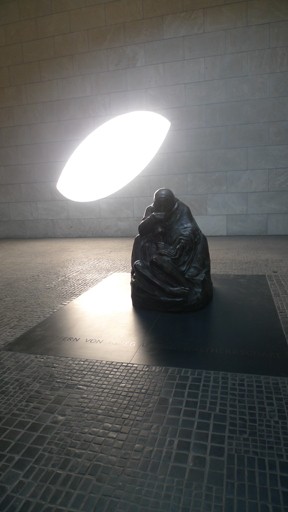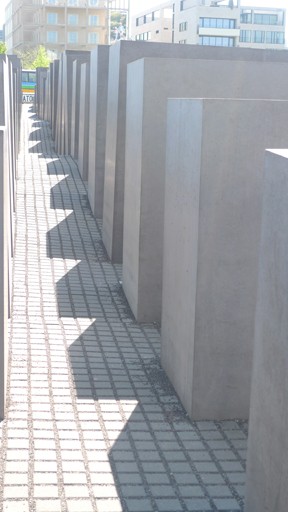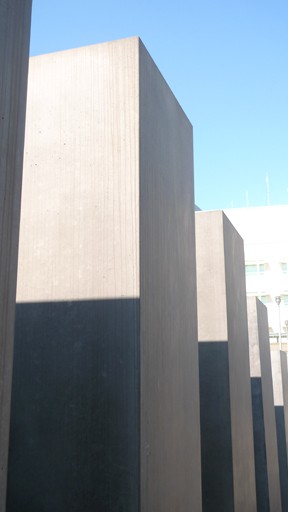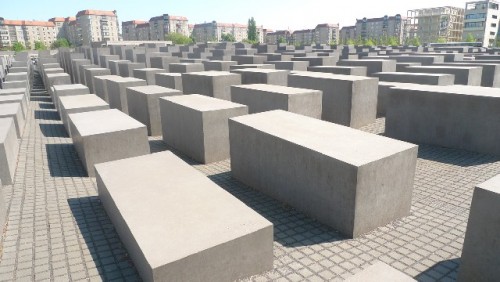Peter Eisenman's Provocative and Thoughtful Memorial To The Murdered Jews of Europe
Public Art As Ambiguous Guilt and Redemption
By: Mark Favermann - Jun 12, 2009
Rebuilt from the devastating rubble of WWII Allied bombing, Berlin is not like any other major city. It is a major restoration project. Few historically significant buildings were spared destruction during the 1940's. Thus, what was old is actually quite newly rebuilt or restored in the city. Since the wall has come down, new buildings have sprung-up like giant futuristic geometric constructs.The City of Berlin is a repository for architectural experimentation and engineering exercises. Some actually work while others just miss. Still others are questionable that they were even built. Few major new buildings have relationship to others while many more are just structural statements. Lord Foster's Reichstag glass dome addition is one of the better pieces of contemporary architecture there. Big and spread out, there is an openness and largeness to Berlin that does not underscore a civic grandeur. In an urban design sense, the sum of the parts in Berlin is not as great as the individual parts themselves. The City of Berlin seems to lack an urban cohesiveness.
This is a result of many ingredients including its dark 20th Century history, the discordant separation by the Berlin Wall, recent exuberant mega-development, etc. Besides the notable and quite beautiful iconic Brandenburg Gate (Tor in German) with its four horse chariot, a statue of Frederick the Great and a few other historical German notables, Berlin is not heavily lined with statuary and monuments like other major European capitols. The city seems piecemeal, either too thoughtfully derived or not thoughtful enough.
Case in point is the windswept Potsdamer Platz which was built from scratch since 1995. It has startlingly large and architecturally evocative buildings, but is unfriendly to pedestrians and unworldly scaled. Maybe, Berlin's city planners and urban designers are being too careful or not creative enough in the right ways. This could lead to another lengthy discussion at another time. However, despite urban design mistakes, there is a significant monument, a major piece of public art strategically placed in the city. It is American architect Peter Eisenman's The Memorial to the Murdered Jews of Europe. It may be one of the great pieces of public art in the world. And, perhaps, Berlin is the only place that it could be properly sited.
The best of public art is civic design. The term public art generally refers to any piece of art that has been planned, designed and fabricated to be specifically sited in the public domain either outside or in public buildings. It is usually accessible to the public. The process of public art includes site specificity, community involvement and civic collaboration. Though, clearly defined, it sounds simple. But the reality is often something else. There are many pieces of public art, but few contemporary ones are great. In Berlin, Eisenman's memorial is one of the great creative pieces of public art.
Though much smaller in scale, there are two other memorable pieces of public art in Berlin as well. One is a sculpture, Woman with Dead Child, by Kathe Kollwitz (1887-1945) at Neue Wache which serves as a monument to the Victims of War and Tyranny. This sculpture is dramatically lit by natural light from an open skylight. Placed in 1993, nearly fifty years after the Expressionist artist died, this enlarged version of a macquette created by the artist is not without controversy. Buried there are an Allied soldier, a citizen of Berlin, a Concentration Camp victim and an unknown Nazi soldier. Ironically or perhaps not so ironically, Kollwitz's original smaller sculpture was to commemorate the loss of her own son during WWI. War and loss are interchangeable no matter the time period. It is said that when it snows, this sculpture is particularly beautiful.
The other public art piece commemorates the Nazi book burning on May 10, 1933. This underground piece below the surface of Bebelplatz austerely states the void created by the destruction of literally and symbolically 20,000 books by Nazi Youth groups, university students and S.A. members. Created by an Israeli artist, Micha Ulman, in 1995, it is a simple underground room enclosed by white empty bookshelves separated from the surface by a thick sheet of glass. These are the empty stacks of a ghost library. Reflecting the bonfire that it commemorates, it is lit at night. This work about censorship and destruction of freedom of thought is eloquent in its silence.
The Memorial to the Murder of the Jews of Europe could have been a devastatingly simple-minded solution. It could have been overwhelmingly maudlin or just morbid. But, architect Peter Eisenman distinguished himself by solving the conundrum of sense of place with a sense of shared cultural experience. Provocatively ambiguous, the Memorial to the Murdered Jews of Europe has a deep resonance. Visually poetic, it has a visual and intellectually disturbing beauty. Its abstracted elements can be seen as train cars, coffins or industrial packaging. Its lack of detail can suggest the inhuman destruction of innocent victims. Its immensity suggests the sheer numbers, 6 million, that were killed. It is brilliant conceptually.
For this project, Eisenman went back to the basics of design. He established a repetitive geometric form, the rectangle and then worked it through spatially and environmentally. There is a striking tonal quality to how it was designed. Environmentally, it has a monotone color quality that changes in light and shadow. Its deceptively simple rectangular shape is varied at different heights and thus, varying volumetric sizes. Here, the designer created a visual rhythm that makes its minimalism somehow humanly complex.
The project was proposed first in 1988 by journalist Lea Rosh. She founded a support group to collect donations for a memorial to the Jewish victims of the Nazi's attempt to exterminate the Jews of Europe. However, in 1989 the Wall fell and focus was redirected by the recently unified German government on rebuilding and reunification of the two Berlins. Several years later, the idea was brought up again. In 1998, a resolution was passed by the German Parliament, the Bundestag, to erect a memorial. Not surprisingly, bureaucratic disagreements over concept and design and a great deal of opposition from many Germans delayed the project.
The actual design took twists and turns as well. A competition was finally held in the mid-1990's. A large number of entries, 528, were received from all over. A plan by artist Christine Jackob-Marks won the initial competition. It included a large sloping concrete surface with the names of the victims carved into the pad. The major cost of this was to be privately donated. Eventually, the design was rejected by the German Prime Minister Helmut Kohl due to its cost, immensity and specific nature of its elements. Among others, details included bringing large boulders from the ancient martyrs Israeli fortress of Masada. The project was deemed too literal, and soliciting sponsors to pay for the names seemed insensitive and awkward.
Interestingly, a sort of people's choice winner was selected at the 1995 exhibition of entries by visitors, critics and German intellectuals. The piece, a conceptual design by artists Frieder Schnock and Renata Stih, was called Bus Stop Proposal. There would be no plaques, no signs and no statues, just locations on a map. The idea was that the bus would take people around to sites that were relevant to the Holocaust both in Berlin and outside as far as the Netherlands and Poland. These included a Jewish orphanage from where 200 children were deported and other more obscure sites. The artists entered the competition with an anti-proposal with no thought of winning. Later that year, they published a"timetable" to show various points that heinous acts of the Holocaust took place.
A smaller invited competition was held in 1997. Peter Eisenman's plan won that competition. In June 1998, the Bundestag approved his design plan with one modification: Eisenman had to include and design an attached museum. His design was highly abstract and monumental in scale while being accessible and intimate. No names or numbers were to be placed on the steles. The viewer's imagination was to internally translate the design. Construction began in the spring of 2003.
And yet another twist occurred. It was discovered that the German company that was to supply some of the materials for the Memorial, the anti-graffiti coating among others, was corporately-related to the company that supplied Zyklon B poison for the Nazi death camps. Construction of the memorial was placed on hold. After review and discussion led by the German and Berlin media, Peter Eisenman recommended that the work continue. He said that it had been almost 60 years and that part of the Memorial was about redemption not just guilt. Work resumed a month later. The large company, Degussa, then donated the anti-graffiti coating chemical to the memorial. The Memorial was finished in December 2004. It was dedicated on May 10, 2005 as part of the 60th anniversary of V-E (Victory in Europe) Day. A week later, it was open to the public. The Memorial is open 24 hours a day.
The Memorial is set on a 19,000 square meter or about 62,000 square foot unevenly sloping site in center city Berlin. The site is between the Brandeburg Gate and the bunker where Hitler committed suicide. Designer Eisenman wanted it to be part of Berliner's daily lives, not as a shrine or holy place, but for it to act as a pass-through or shortcut for pedestrians as part of their normal routine. There are 2,700 concrete slabs or steles arranged in a grid pattern. Each stele is 2.38 meters long, .95 meters wide and vary in height from .2 meters to 4.8 meters.
There is no prescribed path as the Memorial can be entered from all sides. Admission is free. An underground "place of information" is set beneath the Memorial. There are no signs that direct visitors to the information center/museum. This is more ambiguity. It holds the names of every known Jewish Holocaust victim. The cost of the Memorial has been estimated at around $40 million.
This Memorial is one of the great designs in Berlin. It symbolizes so much in a simple, dignified way. There are those who do not like it, even find it insulting. Even neutral public art has detractors. Those like this one pregnant with controversy and contradiction have even more negatives associated with them. Serious individuals find it overly large, sprawling with a numbing lack of aesthetic appeal. To them, the minimalist slabs offend rather than evoke poetic metaphors. But to those who appreciate its abstract sophistication, the Memorial can be seen as a major statement of guilt, a statement of redemption and a statement of rebirth, much like the City of Berlin and the German people.













